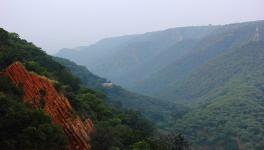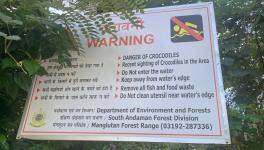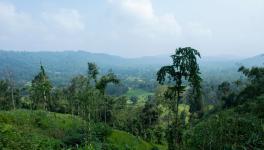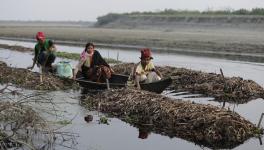Govt Solution to Tackle Annual Floods in Assam Expensive and Unlikely to Work
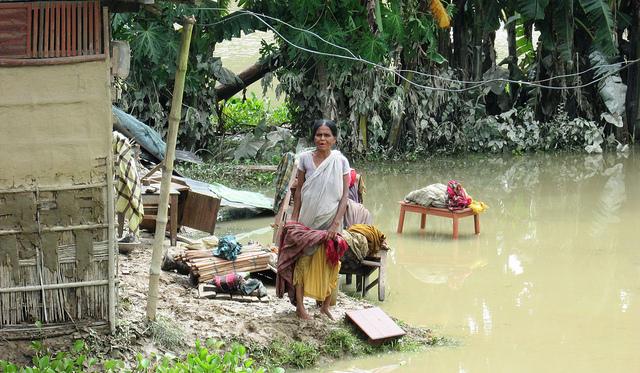
Credits: Oxfam International
Year after year, floods ravage the state of Assam, taking lives and displacing livelihoods. There has since long been a demand to address this annual problem of widespread devastation and destruction. But the solution Assam’s government is planning to implement is expensive and unlikely to work.
The Central and State governments have announced that dredging will be performed on the Brahmaputra river as a “permanent” solution to floods at a budget of Rs 400 crores. In July, Nitin Gadkari, Union Minister of Road Transport & Highways and Shipping, stated that dredging will start by September. Although after nearly three months nothing has been done on ground, dredging is neither a solution nor is it permanent.
The government is planning to send “dredgers” to the Brahmaputra river to dig out deposited silt from its bottom. This is being done to increase the water holding capacity of the river, and prevent floods when the flow of water increases. This will be done by the Dredging Corporation of India (DCI). These dredgers are vessels which are equipped with big cutter heads. The head is sent to the river bed, which then rotates and breaks down the soil into small pieces. These pieces are sucked up by pumps and transported to the shore using pipelines. There is a plan to use the dredged up soil for creating a 725km long expressway along both the river banks. This expressway will take the cost of the project up to Rs 40,000 crores.
Assam Chief Minister Sarbananda Sonowal believes that this will not only improve the water carrying capacity of the river, helping in preventing floods, but will also make the river more navigable for cargo ships.
But even if the river bed is deepened by removing silt from the bottom, new sediment will not take long to be deposited again. Brahmaputra has a heavy, varying sediment load. The river along with its tributaries is estimated to carry around 1.8 billion tonnes of silt every year, depositing it on the river bed along the way. Deforestation and infrastructure development in the upper hills of the region also contribute to this high amount of silt. If this plan is implemented, a tremendous amount of silt will have to be dredged.
Moreover, there have already been attempts to dredge Brahmaputra in the 1970s. It was attempted twice then, but it failed as silt deposited again. Globally, it is well established that dredging alone cannot solve the problem of floods.
Even if extensive and repeated dredging is performed, there is no guarantee that the increase in water carrying capacity of the river will be sufficient to hold the flow of water during floods. It is, in fact, expected to increase the risk of flooding for settlements downstream as water will flow faster after dredging.
Dredging is not a real solution to flooding, and it can raise other major problems. It can cause erosion of river banks because of decrease in stability, and it will disturb the natural habitat of marine life. This can lead to loss of species in the area as they might die or migrate.
Instead of digging up rivers time and again at huge costs and environmental damage, a more scientific and wholesome approach needs to be taken. A committee was constituted by the government in 2016 for studying the problem of sedimentation in Ganga. This committee, the Chitale Committee, also said that de-siltation does not have a direct impact on improving the environmental flow of the river.
There are massive catchment areas around Brahmaputra which need to be dealt with if the flow of the river is to be controlled during floods. Catchment areas are pieces of land adjacent to water bodies which collect surface water from rains and melting ice and feed it to the water body. Chitale committee recommended that good agricultural practices in these catchment areas can prevent too much silt from being deposited in the river.
Afforestation and growth of vegetation have also been recommended as solutions to the problem of excessive sedimentation. Along with controlling the amount of silt that is deposited in the river, the increase in vegetation will also be able to hold more water.
The solution that the government has currently proposed will only serve as an illusion of action meant for instant results. The causes for floods are complicated, and the aggravation in recent years can be attributed in part to changing climate from human activity. Such a complex and extended issue cannot be expected to resolve from the kind of instant solution the government is planning to implement.
Get the latest reports & analysis with people's perspective on Protests, movements & deep analytical videos, discussions of the current affairs in your Telegram app. Subscribe to NewsClick's Telegram channel & get Real-Time updates on stories, as they get published on our website.









